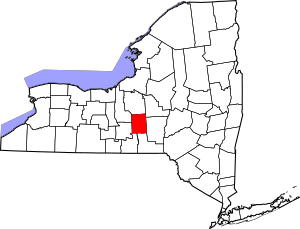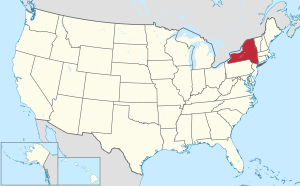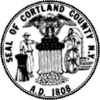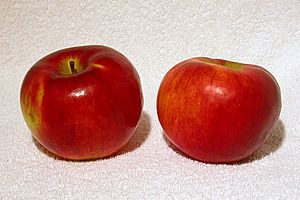Cortland County, New York facts for kids
Quick facts for kids
Cortland County
|
|||
|---|---|---|---|

Cortland County Courthouse
|
|||
|
|||

Location within the U.S. state of New York
|
|||
 New York's location within the U.S. |
|||
| Country | |||
| State | |||
| Founded | 1808 | ||
| Named for | Pierre Van Cortlandt | ||
| Seat | Cortland | ||
| Largest city | Cortland | ||
| Area | |||
| • Total | 502 sq mi (1,300 km2) | ||
| • Land | 499 sq mi (1,290 km2) | ||
| • Water | 2.8 sq mi (7 km2) 0.5% | ||
| Population
(2020)
|
|||
| • Total | 46,809 | ||
| • Density | 93.8/sq mi (36.2/km2) | ||
| Time zone | UTC−5 (Eastern) | ||
| • Summer (DST) | UTC−4 (EDT) | ||
| Congressional district | 19th | ||
Cortland County is a county in the state of New York, United States. In 2020, about 46,809 people lived here. The main town and government center is Cortland.
The county gets its name from Pierre Van Cortlandt. He was important in writing New York's first constitution in 1777. He also became the state's first lieutenant governor. Cortland County is part of the Central New York region.
The famous Cortland apple is named after this county!
Contents
History of Cortland County
Early Days and Settlement
Cortland County is in the Appalachian Plateau area of Central New York. It sits between the cities of Syracuse and Binghamton. This area was once home to the Iroquois people, also known as the Haudenosaunee, starting around the year 1500.
Before the American Revolution, this land was part of Native American territory. After the war, in 1781, New York State set aside over a million acres of land. This land was called the "Military Tract." It was meant to reward soldiers who fought to protect the state.
To help people move into this wild area, a road was built from Oxford to Cayuga Lake between 1792 and 1794. Other roads were also built by private groups. These roads helped many new settlers come to the area.
When New York first created counties in 1683, Cortland County was part of a very large Albany County. Over time, it became part of different counties as New York grew. These included Tryon County and Herkimer County. Finally, in 1794, it became part of Onondaga County.
Forming Cortland County
People from eastern New York and New England wanted new land for farming. They were excited to move to this new frontier. The first European settlers arrived in 1791. They were Amos Todd, Joseph Beebe, and Rhoda Todd Beebe from Connecticut. They traveled up the Tioughnioga River to settle near the town of Homer.
Many more settlers followed them. By 1808, they asked the state government to make their area a separate county. So, on April 8, 1808, Cortland County was officially created. It was formed from the southern part of Onondaga County. The county was named to honor the Pierre Van Cortlandt family.
Cortland County in the 1800s
During the American Civil War, many men from Cortland County joined the army. One famous group was the 76th New York Volunteer Infantry. This group was formed in 1861, mostly from Cortland County and nearby areas.
The 76th New York fought in many major battles. These included battles from Second Bull Run to Petersburg. At the Battle of Gettysburg, the 76th New York was one of the first groups of soldiers on the battlefield. They held an important position on the first day of the battle. The regiment lost many soldiers in that battle, including their leader, Major Andrew J. Grover.
Cortland County Today
Today, Cortland County is known for making many different products. These include CNC milling machines, supplies for hotels, and medical instruments. They also make textiles, electronic components, and plastic goods. Some companies even make parts for NASA! Many businesses in the area sell their products to other countries.
Farming is still important in the county. While there are fewer farms now, they are larger and produce more food. Other industries, like services and light industry, are also growing. This helps the economy of the Central New York and Southern Tier regions.
Cortland County is also a place for learning. Several colleges and universities are nearby. These include Cornell University, Syracuse University, and Binghamton University. Within the county, you'll find the State University of New York College at Cortland and Tompkins Cortland Community College.
Geography of Cortland County
Cortland County covers about 502 square miles. Most of this is land, with about 2.8 square miles of water.
The county is located in the southwest part of New York. It is south of Syracuse and north of Binghamton. It is considered part of both the Central New York and Southern Tier regions.
Neighboring Counties
- Onondaga County - to the north
- Madison County - to the northeast
- Chenango County - to the east
- Broome County - to the south
- Tompkins County - to the west
- Tioga County - to the southwest
- Cayuga County - to the northwest
Main Roads
 Interstate 81
Interstate 81 U.S. Route 11
U.S. Route 11 New York State Route 13
New York State Route 13 New York State Route 41
New York State Route 41 New York State Route 90
New York State Route 90 New York State Route 392
New York State Route 392
Population Data
| Historical population | |||
|---|---|---|---|
| Census | Pop. | %± | |
| 1810 | 8,869 | — | |
| 1820 | 16,507 | 86.1% | |
| 1830 | 23,791 | 44.1% | |
| 1840 | 24,607 | 3.4% | |
| 1850 | 25,140 | 2.2% | |
| 1860 | 26,294 | 4.6% | |
| 1870 | 25,173 | −4.3% | |
| 1880 | 25,825 | 2.6% | |
| 1890 | 28,657 | 11.0% | |
| 1900 | 27,576 | −3.8% | |
| 1910 | 29,249 | 6.1% | |
| 1920 | 29,625 | 1.3% | |
| 1930 | 31,709 | 7.0% | |
| 1940 | 33,668 | 6.2% | |
| 1950 | 37,158 | 10.4% | |
| 1960 | 41,113 | 10.6% | |
| 1970 | 45,894 | 11.6% | |
| 1980 | 48,820 | 6.4% | |
| 1990 | 48,963 | 0.3% | |
| 2000 | 48,599 | −0.7% | |
| 2010 | 49,336 | 1.5% | |
| 2020 | 46,809 | −5.1% | |
| U.S. Decennial Census 1790-1960 1900-1990 1990-2000 2010-2020 |
|||
2020 Census Information
In 2020, the U.S. Census counted the people living in Cortland County. Here's a quick look at the different groups:
| Race | Number of People | Percentage |
|---|---|---|
| White | 40,801 | 87.16% |
| Black or African American | 829 | 1.8% |
| Native American | 113 | 0.24% |
| Asian | 1,018 | 2.17% |
| Pacific Islander | 6 | 0.01% |
| Other/Mixed | 2,384 | 5.1% |
| Hispanic or Latino | 1,658 | 3.54% |
Education in Cortland County
Cortland County has several schools and colleges for students of all ages.
- State University of New York at Cortland
- Tompkins Cortland Community College
- Cincinnatus Central School District
- Cortland City School District
- Homer Central School District
- Marathon Central School District
- McGraw Central School District
Communities and Towns
Larger Towns and Villages
Here are some of the bigger communities in Cortland County:
| # | Location | Population | Type | Town(s) within |
|---|---|---|---|---|
| 1 | †Cortland | 19,204 | City | Cortlandville |
| 2 | Homer | 3,291 | Village | Cortlandville, Homer |
| 3 | Munsons Corners | 2,728 | CDP | Cortlandville |
| 4 | Cortland West | 1,356 | CDP | Cortlandville |
| 5 | McGraw | 1,053 | Village | Cortlandville |
| 6 | Marathon | 919 | Village | Marathon |
| 7 | Blodgett Mills | 303 | CDP | Cortlandville |
| 8 | Virgil | 298 | CDP | Virgil |
Other Towns
Famous People from Cortland County
Many interesting people have come from Cortland County:
- William Dillon – a composer and writer of songs for vaudeville shows.
- Ronnie James Dio – a famous singer for the bands Rainbow and Black Sabbath. A street in Cortland is named after him!
- Nancy Duffy – a news person from Syracuse who started the Syracuse St. Patrick's Day Parade.
- John McGraw – a Hall of Fame baseball player and manager from the town of Truxton.
- Alton B. Parker – a politician who ran for president in 1904.
- Arthur C. Sidman – a writer for plays and vaudeville shows.
- Elmer Ambrose Sperry – a brilliant inventor who created the gyroscopic compass. He held over 400 patents! A U.S. Navy ship, the USS Sperry, is named after him.
- Sam "Trips" Tripoli – a comedian and podcaster.
See also
 In Spanish: Condado de Cortland para niños
In Spanish: Condado de Cortland para niños




